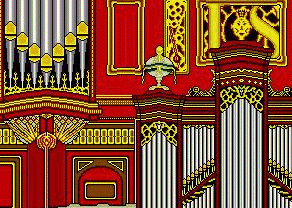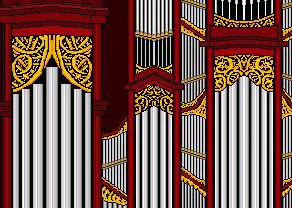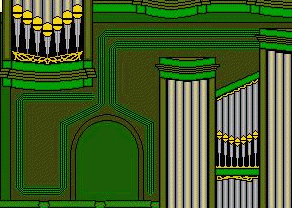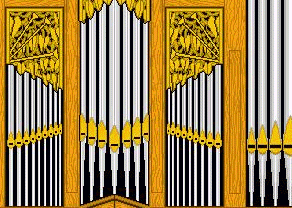The Wayward
Isles | Site Index | John Cowper Powys |
Home | Memoirs | Letters & Journals | Miscellaneous Pieces |

Part 2 |
To hear a midi file, just click on any organ graphic. To stop the music before it has finished, refresh the page. NB Firefox may refuse to play some tracks or cut them short. Try a different browser!
The pipe organ is a marvel of technology
and beauty, that goes back to ancient times. I would like to be able to recount its
history, but have not yet found the time required to do this interesting research. Its
modern equivalent is the synthesizer. By clicking on these images, you will hear
compositions by J S Bach being played "live" on your own computer (if you have a
sound card with midi enabled) on a tiny but fully-featured synthesizer. |

|

|
As with the various kinds of
bagpipe, but unlike brass and wind instruments, two functions are separated in designing
this extraordinary kind of musical instrument. The first is to provide the wind to make
the pipes resonate: this requires physical effort but less skill. The second is to play
the instrument - more skill but less physical effort. I guess that in Bach's day,
someone was at the back of the organ operating the bellows. Today that's all done
electrically.
Both organ and synthesizer are designed to place at the player's disposal a range of
voices - "stops" in organ parlance, "patches" in synthesizer parlance. |
The demand for cheap music to entertain the
common people in the street and elsewhere led to the invention of the barrel organ and
later the steam-operated fairground organ. The "organ-grinder" merely turned a
handle, like an itinerant knife-grinder, to generate the wind which activated the reeds or
pipes, and to activate the automated musical score. I don't know if this consisted of
punched holes, as on the Jacquard loom which inspired Herman Hollerith to invent punched
cards for the 1890 US Census; or consisted of pins on a metal drum, like the musical box.
But midi files do the same thing with a string of digital instructions to a synthesizer. |

|

|
These midi files were sequenced by various people to simulate the sound of
various traditional instruments. To bring out the counterpoint more clearly, and make them
sound fresher to the modern ear, I have used a software called Midikeyz, supplied by
Hammer Software to alter tempi, change "instruments" etc. I don't entirely know
how it works - the passacaglia (panel opposite) goes on to choose its own instruments
after a while!

Click on their logo to view their site. They offer midikeyz as shareware - try before
you buy. |
Special thanks to Lubbert Schenk
of Softart Design, for use of the images derived from his brilliant paintings of organs,
or, in Dutch, Digitale tekeningen van bestaande pijporgels, en eigen ontwerp. To
see these paintings in all their glory, click this logo:

|
Grateful thanks also to B R Travis and his site: "A Johann Sebastian Bach
Midi Page", from which all the pieces on this page have been downloaded and then
"tweaked".
For more midi files, orchestrated in various ways, click this portrait. |

|
More like this:
Cacophonia Part 1
Cacophonia Part 3
Cacophonia Part 4
Email address protected by JavaScript.
Please enable JavaScript to contact me.
The Wayward Isles | Site
Index | John Cowper Powys | Home | Memoirs | Letters & Journals | Miscellaneous Pieces
|